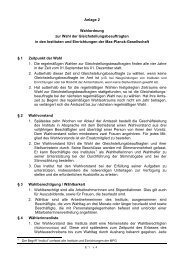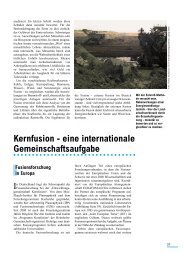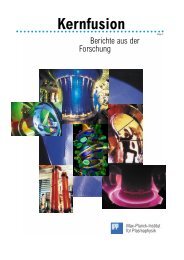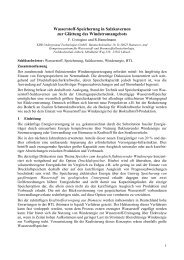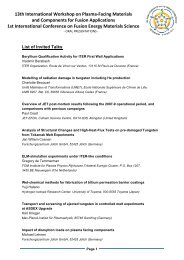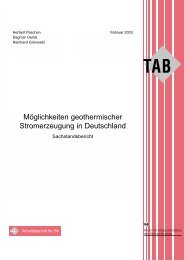IPP Annual Report 2007 - Max-Planck-Institut für Plasmaphysik ...
IPP Annual Report 2007 - Max-Planck-Institut für Plasmaphysik ...
IPP Annual Report 2007 - Max-Planck-Institut für Plasmaphysik ...
You also want an ePaper? Increase the reach of your titles
YUMPU automatically turns print PDFs into web optimized ePapers that Google loves.
Tokamak Physics Division<br />
Head: Prof. Dr. Sibylle Günter<br />
Tokamak Edge Physics Group<br />
Work in the group has balanced<br />
the use of existing codes to understand<br />
phenomena in the edge plasma<br />
(or to identify discrepancies<br />
between code and experiment),<br />
and the improvement of the codes.<br />
Current edge codes form an important<br />
bridge between results<br />
on present machines and divertor operation on ITER. The<br />
present ITER divertor is based to a large extent on the results<br />
of simulations with one of the existing edge codes, while a<br />
number of edge codes are in use to understand present day<br />
experimental results. To place the ITER predictions on a<br />
firmer footing, an effort has been made to verify the existing<br />
codes by careful code-code comparison, and then to validate<br />
the codes against the experiment. This is done within the<br />
framework of an ITPA DivSOL activity (DSOL-14), and<br />
also as part of the activities of the EU Task Force on<br />
Integrated Tokamak Modelling. In 2004, the results of the<br />
EDGE2D-NIMBUS, B2-EIRENE (SOLPS5) comparison<br />
for the D only case were reported together with some preliminary<br />
results with drifts. During the <strong>2007</strong> JET edge modelling<br />
campaign, these results were extended to D+C for<br />
SOLPS, and some results for D and D+C for EDGE2D-<br />
NIMBUS and EDGE2D-EIRENE were also obtained. One<br />
of the major results was a renewed look at the atomic<br />
physics being used in the edge codes. For one particular<br />
case, the peak target electron temperature was found to<br />
change by a factor of nearly 10 depending on the choice of<br />
atomic physics (for hydrogen).<br />
In-depth examination of earlier identified discrepancies<br />
between SOLPS modelling and AUG experimental data was<br />
continued. Three types of discrepancies – in the divertor<br />
electron temperature T e , radial electric field E r and Mach<br />
numbers of parallel ion flow in the main scrape-off layer<br />
(SOL) M || – were linked together. A consistent picture of the<br />
problems encountered by the code modelling has been confirmed.<br />
The leading assumption about the origin of the discrepancies<br />
is the neglect of kinetic effects in the parallel electron<br />
heat transport from the SOL to divertor. Analysis of publications<br />
related to the role of kinetic effects in the SOL reveals<br />
a significant effect which they can have on the electron distribution<br />
function near the target, resulting in higher parallel<br />
electron heat flux and a large Debye sheath drop at the target.<br />
Work has started on developing a kinetic treatment for the<br />
edge plasma, with the intention of either coupling this to B2,<br />
or to try to parameterize the results in some fashion for<br />
inclusion in the fluid plasma code. In continuation of a project<br />
on disruptions at JET, a series of modified pre-disruptive<br />
Theoretical Plasma Physics<br />
Head: Prof. Dr. Per Helander<br />
The project “Theoretical Plasma Physics” is devoted<br />
to first-principle based model developments<br />
and combines the corresponding efforts of<br />
the divisions Tokamak Physics and Stellarator<br />
Theory, of the Junior Research Groups “Turbulence<br />
in Magnetized Plasmas”, “Theory and Ab Initio<br />
Simulation of Plasma Turbulence”, and “Computational<br />
Material Science”, and the EURYI Research<br />
Group “Zonal Flows”. It is headed by one theorist<br />
on the board of scientific directors at a time.<br />
81<br />
JET equilibria has been subjected<br />
to thermal quench modelling<br />
with the SOLPS package.<br />
Development of version 6.0 of<br />
the SOLPS package supporting<br />
adaptive mesh refinement has<br />
continued. Based on the current<br />
implementation of the B2 fluid<br />
code, approaches to implement a<br />
generalized framework for the solution<br />
of the fluid equations have<br />
been studied. The main focus lies<br />
on higher-order schemes for conservation laws on unstructured<br />
quadrilateral meshes and efficient data structures enabling<br />
later parallelization of core components of the code.<br />
Other work included: (1) continuing activities associated<br />
with the EFDA Task Force on Integrated Tokamak Modelling;<br />
(2) maintenance, support, and further development of<br />
the SOLPS code; (3) supporting the use of SOLPS at <strong>IPP</strong> to<br />
(i) explore the differences between L- and H-mode edge profiles<br />
in terms of the derived transport coefficients, (ii) explore<br />
the impact of a killer gas puff on AUG, and (iii) explore the<br />
process of detachment.<br />
MHD Theory Group<br />
Heat Transport in Magnetic Islands<br />
Heat diffusion studies using a recently developed numerical<br />
scheme were continued. For cylindrical geometry, heat diffusion<br />
across magnetic islands and ergodic layers has been<br />
studied in detail. The effect of the observed island temperature<br />
flattening on the stability of Neoclassical Tearing Modes<br />
was examined. It was found that the neoclassical island drive<br />
is significantly stronger for realistic island parameters than<br />
predicted by Fitzpatrick 1 .<br />
A new code has been implemented which applies the numerical<br />
scheme to toroidal geometries using straight field line<br />
coordinates. First results for magnetic islands and ergodic<br />
layers in realistic ASDEX Upgrade equilibria suggest that<br />
cases with realistic heat diffusion anisotropies can be very<br />
well resolved.<br />
Fully Three-dimensional Resistive Wall Mode and Feedback<br />
Stabilization Studies<br />
The feedback stabilization of Resistive Wall Modes (RWMs)<br />
has been studied in the presence of multiply connected wall<br />
structures using the fully three dimensional CAS3D, STAR-<br />
WALL, and OPTIM codes. The coupling of toroidal modes<br />
in 3D has been taken into account. The codes have been<br />
applied to an ITER and an ASDEX Upgrade like equilibrium<br />
with β N =2.51 and β N =2.62, respectively. For both cases stable<br />
solutions have been found.<br />
1 R. Fitzpatrick, Physics of Plasmas 2, 825 (1995)






